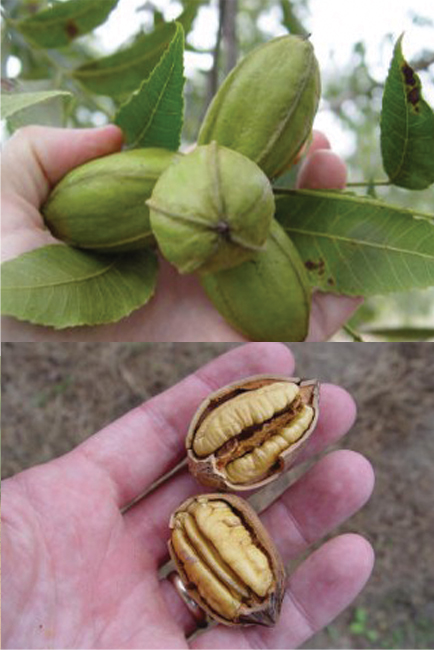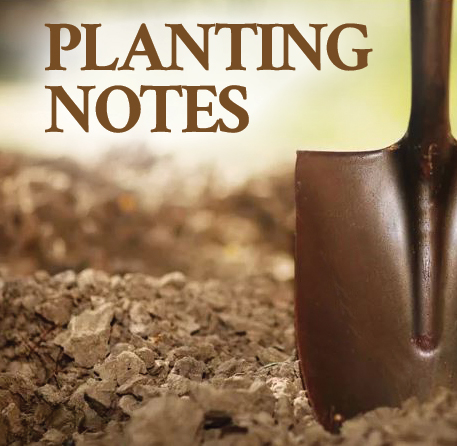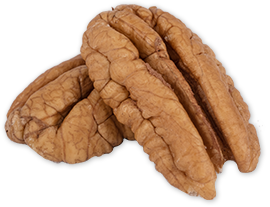We’re nuts for our Clough Pecan patented pecan varieties.

Andy Clough, Jr. has patented two pecan varieties,
’Eclipse’ and ’Excel,’ which are available as bare root trees from the
Clough Pecan Company tree nursery.

It is best to transplant bare-root trees while they are dormant, between December and March. To successfully grow pecan trees, it is important to water them regularly for the first two to three years. While you do not want to put fertilizer in the planting hole when transplanting – fertilizer can burn the roots, damaging or even killing the tree – you do want to apply fertilizer (about one pound of 5-10-5) in June after planting, distributing it in a 25-square-foot area around the tree, but not within 12 inches of the tree’s trunk. The following year, apply one pound of 10-10-10 fertilizer in March and in June, but again, keep the fertilizer away from the trunk.

Nursery Tree Pricing:
3-4 Ft bare-root nursery trees: $14 each
4-5 Ft bare-root nursery trees: $16 each
5-6 Ft bare-root nursery trees: $18 each
6 Ft+ bare-root nursery trees: $20 each
*Add $3 per size for Avalon & Ellis bare-root trees
Orders are taken year round for nursery trees. However, the trees sell out fast each year, therefore place your orders early. Six months minimum, in advance, is suggested for large orders.
Custom Graftings Available -Pre-planning is a must for custom grafting. Call for details: 912-449-4585
No trees are shipped. Trees must be picked up from Clough Pecan Nursery. Pick up is in January and February as most trees need to be in the ground by March 5th.
Nursery@CloughPecan.com for more info on bare-root nursery trees from Clough Pecan.
Eclipse – Clough Pecan Patented Variety
Andy Clough discovered a seedling of the ’Eclipse’ pecan variety in a cultivated area on the Clough Pecan Company farm. Noting the exceptionally early harvest date, high nut quality, good productivity, and resistance to scab disease and other pests, Andy took graft wood of the original ’Eclipse’ pecan tree and propagated it by inlay bark grafting onto approximately 50 trees in the Clough test orchards. Additionally, wood was provided for testing purposes to Dr. Bill Goff of Auburn University, who propagated 12 ’Eclipse’ pecan trees in a research planting at the Auburn University E.V. Smith Research Center near Tallassee, Ala. in spring 2010. In all cases, all horticultural traits observed including leaf shape color, and morphology, bud form, bark color and texture observed are identical to the parent tree, as is normal and expected when pecan trees are propagated by grafting.
Characteristics of the tree and nuts, and history of origin, lead to speculation that the parents may be ‘Moore’בPawnee’. The nuts resemble ‘Pawnee’, though earlier and more scab resistant. Bark color and texture resemble ‘Moore’. ’Eclipse’ has an extremely early harvest date, about two weeks earlier than ‘Pawnee’. No other known pecan cultivar has a harvest date this early. The nuts are longer and more slender than the ‘Pawnee’ nuts, with thin shells like Pawnee’, and kernels are similar to ‘Pawnee’, with bright kernel color and occasional flecking. Yield seems to be greater than ‘Pawnee’ and demonstrates less alternate bearing.
’Eclipse’ is a Type 1 pollinator requiring a Type 2 pollinator for nut production. ’Eclipse’ averages 60 nuts per pound and 55% kernel. ’Eclipse’ is hardy in USDA Zones 5a-9b.
Excel – Clough Pecan Patented Variety
Andy noticed a tree of the ’Excel’ pecan variety, estimated to be 20 to 25 years old at the time of discovery, growing in the Clough orchards in 1990. The tree’s superior characteristics earned it the name ’Excel’. In particular, ’Excel’ is an early bearing tree with fruit maturing and ready for harvest about the first week in October, or two weeks earlier than the standard ‘Stuart’ variety. Surprisingly, ’Excel’ actually blooms out later than the ‘Stuart’ variety, yet produces mature nuts that ripen earlier.
’Excel’ displays a semi-dwarf type growth with small twiglets. Thin limbs and sparse leaf canopy give it a willowy look, but allow for good air circulation and sunlight which help prevent insect and disease damage.
’Excel’ bears a relatively good crop at an early age; trees have been shown to bear at three years after transplanting, with increased heavy production thereafter. It has a large nut, producing about 50 nuts per pound. The fruit has a thick shell, making it bird resistant, and has an excellent quality that yields about 51%. The kernels are a golden color with a heavy oil content. It shells well, and kernels typically fall out in full, complete halves.
A large nut size means ’Excel’ will need plenty of water in August and September. ’Excel’ can be harvested in late September through early October in most years. ’Excel’ is hardy in USDA Zones 5a-9b.









